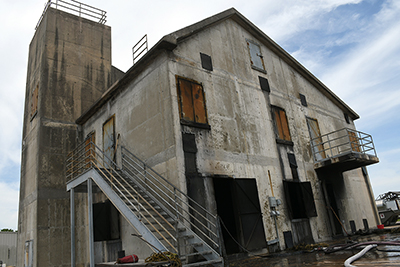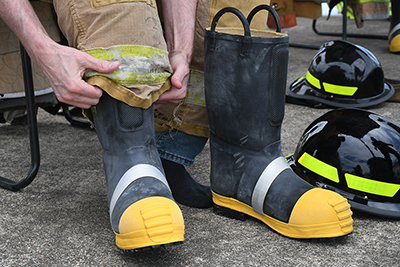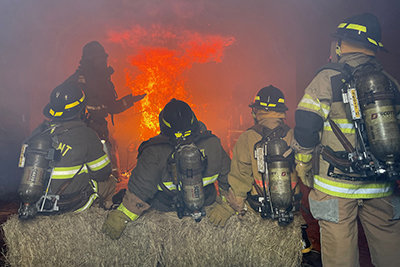'Firefighter for a Day' turns up heat for San Jac employees

"Watch. The fire is about to come across the ceiling."
Whoosh! You look up. Crackling orange flames have gone from climbing the walls to rolling overhead toward you. The infrared camera in your hand registers 1,000-plus degrees. Sparks glisten in the air. Smoke engulfs the room.
You're not a firefighter, but it's a good thing you're encased in full firefighter gear. It's also a good thing this is only a 10-minute fire science exercise.
"Firefighter for a Day" invites San Jacinto College employees to suit up and feel the burn at the La Porte Fire Training Facility, where College cadets practice searching, rescuing, and controlling fires.
This April, San Jac's fire protection technology program offered the two-hour experience for the first time since the pandemic began.
Raising awareness
Cadets undergo extensive training to prepare for the real deal. "Firefighter for a Day" showcases their training and equipment.
"We started this to familiarize our decision-makers with the program," Woody Dunseith, program director, said. "We do lots of things other programs don't, and we buy lots of things other programs don't."
Now the program offers "Firefighter for a Day" to any San Jac employee, some of whom don't know the College trains future firefighters.
"We would have potential students call the College for information only to be told we didn't have a firefighting program," Dunseith said.
Becoming a short-term firefighter, you sense not only the intense training cadets undergo but also the immense dangers of the profession.
Gearing up
Suiting up, you face round after round of buckles, snaps, straps, and tabs. With each cinched strap, your protection notches up another level.
The three-layered pants and jacket contain a flame-resistant exterior, while a quilted interior acts as a thermal barrier next to your skin. You are toasty, but air still circulates until you bend your elbows or knees. After pulling on boots, you strap on the 25-pound self-contained breathing apparatus — a backpack that rests on your hips, not your shoulders.
Over your hood, you tug on the mosquito-like mask and pull the tabs at your chin and temples. Pressing your palm against the mouth opening, you breathe in to ensure an airtight seal around your face. A regulator fits into this opening and twists to seal.
Suiting up takes you at least 10 minutes, while a firefighter cadet must do it under two.
Last, your equipment includes a motion-detection sensor. If you don't move for 20 seconds, a pre-alarm goes off. Twelve seconds later, red lights flash and a shrill signal alerts to a possible firefighter down. Shaking your hips kills the alarm.
Turning up the heat
Fully suited, you and three other employees shuffle into the training facility. The multi-story concrete building has metal doors, hatches, and windows for home, commercial, and maritime scenarios.
One instructor stays with each of you in case you need help or you panic.
You sit on haybales inside a concrete room, doors slammed shut, only one window open behind you. Your neighbor sums up the scene in one word: claustrophobia.
About 10 feet away, firefighters ignite another set of haybales. The flames, leaping up, slowly intensify from a crackle to a roar. You point an infrared camera at them, and the temperature jumps from three digits to four.
Mesmerized, you inhale, and cool, fresh air fills your lungs. Good. Your self-contained breathing apparatus is working. The environment feels real, but your brain reminds you this is only a scenario. Suddenly, you snap back to life and start swaying. Your alarm is going off.
The firefighters use a direct attack on the fire, snuffing out the flames by hosing the base of the fire.
Next, they torch the haybales a second time. These flames finally reach and cross the ceiling, advancing toward you.
Gravity pulls your air tank backward, and you stand to let the weight rest on your hips again. Closer to the ceiling now, your helmet starts to bake.
When the firefighters turn the hose onto these larger flames from farther back, water and fire collide to produce steam. As if you had opened a giant dishwasher, humidity engulfs you. This steam feels hotter than the fiery room alone.
Facing reality
Exiting the building, you think only of unsnapping, unbuckling, and uncinching.
You shed piece after piece of equipment, scrape wet hair from your face, and flap your shirt to circulate air. And the whiff that hits your nose? Like you've been working a barbecue cookoff all day.
Suddenly, it sinks in. You were wearing full firefighter gear next to a controlled indoor bonfire only 10 minutes. You were observing, not fighting. Standing on the sidelines, not rushing into the furnace.
Real firefighters suit up not just once but countless times to enter burning buildings, rescue trapped people, and tame infernos. They are courageous, compassionate, and — yes — calm in the face of crisis.
You gulp. Thank heaven for firefighters.
Fired up about a life-saving career?
Have you dreamed of becoming a firefighter since you were a kid? San Jac can turn that dream into a career. Check out our firefighter training academy, now at the Maritime Campus!
- Visit: sanjac.edu/programs/areas-of-study/public-services/fire-protection/
- Call: 281-476-1834
Group and scenario photos courtesy of fire protection technology program



